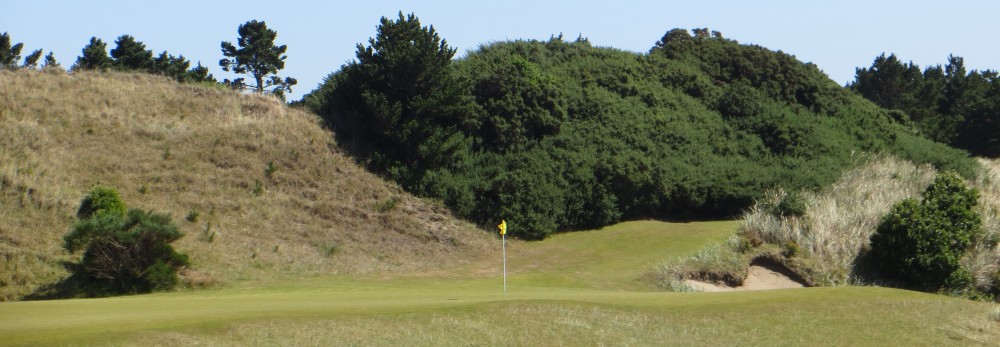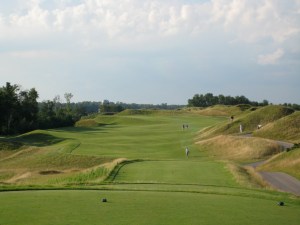 The Kohler/Whistling Straits resort is something to behold, it has first class accommodations, great food, wonderful service, and four, count em, four Pete Dye golf courses. But the thing that put this place on the map is The Straits course which has already hosted two PGA Championships, a U.S. Senior Open, and will be the host of another PGA in 2015 and the Ryder Cup in 2020.
The Kohler/Whistling Straits resort is something to behold, it has first class accommodations, great food, wonderful service, and four, count em, four Pete Dye golf courses. But the thing that put this place on the map is The Straits course which has already hosted two PGA Championships, a U.S. Senior Open, and will be the host of another PGA in 2015 and the Ryder Cup in 2020.
There are two things that are startling about The Straits. First it is essentially a links style course in the middle of America and second, everything you see that makes this a links style course, except for the ocean sized Lake Michigan over your shoulder, was manufactured by man. The not so startling fact is that Pete Dye had the audacity to conceive and pull off the first two.
The fact that he was convinced he could create a links style layout from scratch with office building sized sand dunes, massive waste areas peppered with endless bunkers, and acres and acres of native links type grasses on what was essentially a pancake flat piece of lakeside ground, formerly an air force target range, is beyond audacious-it was almost egotistical. But Pete has never suffered for lack of self confidence and damned if he did not pull it off. He even has the signature sheep wandering the course to make it feel like you are playing an old links course in rural Ireland.

They may be cute but they will mooch your peanut butter crackers.
Besides the engineering feat of importing and placing about 8,000 truckloads of dirt from Indiana to sculpt the land, Pete had to conceive of a routing to expose as many of the holes as possible to the lake winds to create the real look and feel of links golf in Wisconsin. It is a figure eight routing with the front nine going south along the lake shore and then looping back upon itself to catch more shoreline on the way back in. The back side does the same thing going north along the shoreline and looping back for more shore on the way back to the clubhouse. This puts 8 of the 18 holes with direct interface to the lake and another six within eye view. The influence of the wind off the lake can be profound and since the holes go in both directions on both sides you rarely get but a couple of holes in a row with the same wind effect.

The quiet tranquility of Number 2 is beguiling.
Pete did his homework and integrated many of the important strategic links characteristics so that the course can be challenge no matter the wind direction and you have a chance to be successful as well. As with most links courses these greens are very long which allows the greens staff to place the pin on the front when the wind is in your face or in the back when the wind is helping-this will make it easier for you to use the green surface to manage your shot into the green. Most of the 500 bunkers are well out of the playing area but the positioning of ones in the driving areas, layup areas, and greensides are staggered so that there always seem to be tactical bunkers in play no matter the prevailing wind.
There is open access at the front of most greens to give you the bump and run option if a lower approach shot is in order. The only failing is the turf is not as firm as you expect on a links course so sometimes those bump and runs will bump and check. Most significantly, the towering dunes and massive waste areas adjacent to the fairways and greens create visual intimidation that make TPC Sawgrass look tame. This psychological collateral can be very significant if you let yourself get too fearful of playing the right shot.

Seventh Hole Par 3 is pure intimidation.
The par threes on this course are all stunners-forced carries over huge waste areas to precipice greens with the backdrop of the lake behind. This lack of topological backdrop can make frame of reference of the shots hard to discern. The wind influence on the three pars is at it’s max because they are the most exposed holes on the course. There are a number of serpentine par fours where Pete used the large dunes to obscure your vision of the target-this is especially true if you hit your drive on the wrong line on the doglegs. The way he wends these holes through the dunes and sets the green complexes against massive backdrops and falloffs creates that links feeling of risk and reward on almost every shot. It takes some moxie to play this course successfully.

The harsh reality of Number 17 will challenge you.
The greens are massive and have lots of slope and tiering. In many cases being on the wrong section of the green is like not being on the green at all. You have to resist playing to the safe side on many of these holes otherwise you will be three putting all day long. Green speeds are affected by slope and grain, but wind is not to be forgotten because it can accentuate the curve and speed of a putt drastically.

Quite the finishing hole
The caddies here are top notch-they are truly professional caddies who understand the course and the tactics for playing it successfully. Heed what they say and ask lots of questions-you need to hit every shot with full confidence out here if you want to play to your handicap.
Don’t forget where you are-I recommend the kilbasa at the turn with some kraut-it is almost indigenous to the region.
Kohler, Wisconsin
Architect: Pete Dye (2004)
Tees Par Rating Slope Yardage
Black 72 76.7 151 7362
Blue 72 74.2 144 6909
Green 72 71.9 137 6459
Red 72 66.9 125 5396
(Click to see complete Straits Course hole-by-hole descriptions)
 With Whistling Straits playing host to the Ryder Cup this week, Andy Johnson of The Fried Egg has dispatched his drone to put together a timely video exposition of the course and paired it with his thoughtful and knowledgeable analysis of how the Pete and Alice Dye’s architecture will provide strategic challenges in this match play competition.
With Whistling Straits playing host to the Ryder Cup this week, Andy Johnson of The Fried Egg has dispatched his drone to put together a timely video exposition of the course and paired it with his thoughtful and knowledgeable analysis of how the Pete and Alice Dye’s architecture will provide strategic challenges in this match play competition.














